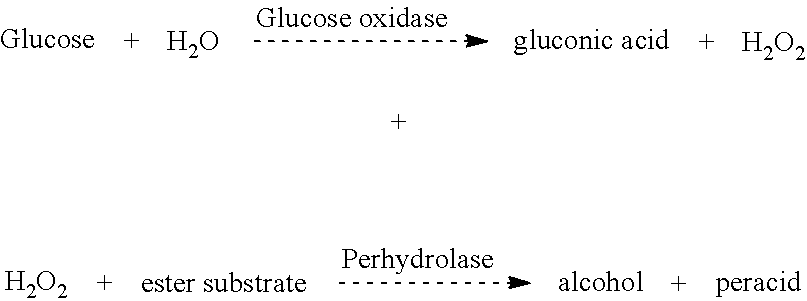Enzymatic textile bleaching compositions and methods of use thereof
a technology of textile bleaching and composition, applied in the direction of detergent composition, surface-active detergent composition, detergent compounding agent, etc., to achieve the effects of reducing textile damage, reducing dye uptake, and softer handling
- Summary
- Abstract
- Description
- Claims
- Application Information
AI Technical Summary
Benefits of technology
Problems solved by technology
Method used
Image
Examples
example 1
Enzymatic Bleach Pretreatment of 100% Cotton Single Jersey Material
[0175]A comparison between enzymatic and chemical bleaching processes was performed using cotton jersey textile material in a batch process in a Mathis AG Lab Jet apparatus.
Bleaching Compositions
[0176]The compositions shown in Table 1 were used in experiments as described below.
TABLE 1Bleaching CompositionsBleachingComposition1234Clarite ® ONEml / l1.51.51.51.5Phosphate Buffer,ml / l1010pH 8Propylene Glycolml / l3.03.0DiacetatePectinaseml / l2.5NaOH 100%g / l1.51.5H2O2 35%ml / l6.04.06.06.0Perhydrolaseg / l1.01.0
[0177]CLARITE® ONE contained the following components:
0.5% (w / w) phosphonic acid [[(phosphonomethyl)imino]bis[2,1-ethanediyl nitrilobis(methylene)]]tetrakis-, sodium salt
5-10% (w / w) alkylethoxylate
15-20% (w / w) isotridecanol, ethoxylated
<5% (w / w) polyacrylic acid, sodium salt
[0178]The phosphate buffer contained 10% soda ash.
[0179]The pectinase was a 10% solution of BIOPREP™ 3000L, available from Novozymes.
[0180]The perhydro...
PUM
| Property | Measurement | Unit |
|---|---|---|
| bleaching temperature | aaaaa | aaaaa |
| temperature | aaaaa | aaaaa |
| temperature | aaaaa | aaaaa |
Abstract
Description
Claims
Application Information
 Login to View More
Login to View More - R&D
- Intellectual Property
- Life Sciences
- Materials
- Tech Scout
- Unparalleled Data Quality
- Higher Quality Content
- 60% Fewer Hallucinations
Browse by: Latest US Patents, China's latest patents, Technical Efficacy Thesaurus, Application Domain, Technology Topic, Popular Technical Reports.
© 2025 PatSnap. All rights reserved.Legal|Privacy policy|Modern Slavery Act Transparency Statement|Sitemap|About US| Contact US: help@patsnap.com

